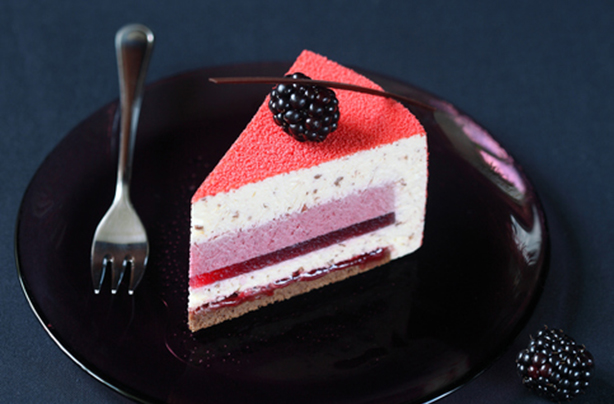What is an entremets and how can you make one?
Multiple desserts in one? The answer is yes, we're in.


Entremets seems to be the bake of the moment, with ambitious cake makers up and down the country keen to give them a go. But what, exactly, are they?
If you are a little confused about what an entremets is then we hear you - we weren't so sure ourselves when we first heard tell of these tasty treats.
But being the inquisitive cooks that we are, we couldn't help but look into it. It's fair to say that we learned a thing or two, and because we're good sharers we've written a quick-fire guide to what one is, and how you can make your own at home.
These French creations have a long history, steeped in traditional flavours and textures, but more recently they've been transformed into a thing of beauty. Here are the most important questions about an entremets, answered…
What is an entremets?

Back in the day an entremets was a sweet offering, traditionally served up at banquets as a little treat between savoury courses. More recently they've become a way of chefs showing off their pastry prowess by way of creating a complex cake made up of various layers of different dessert techniques. Which also means this is the perfect pud for the indecisive.
Each entremets should include layers that each give textures of spongy, creamy, bubbly, crunchy and wobbly. Each of these should be a different but work well together for an overall delicious flavour.
These layers are commonly separated by a mousse (the bubbly layer), which helps give distinctive lines when the cake is cut into. The layers themselves usually include a light sponge, like a genoise, for the spongy texture. This slightly firmer layer gives the finished cake a sturdy structure, so that when the centre is revealed it's beautifully streamlined. For the creamy, crunchy and wobbly elements chefs often introduce set custards, pralines and jellies.
Parenting advice, hot topics, best buys and family finance tips delivered straight to your inbox.
How can I make an entremets?

Despite their complex appearance entremets aren't as tricky to make as you might think. The key to getting yours perfectly layered is to have patience. The whole thing needs to be chilled well before it can be enjoyed.
First thing is first, you'll have to pick your flavour – whether you're a strawberry or a chocolate fan, now is the time to choose. For argument's sake we're going to step by step you through a light vanilla and strawberry kind with just three simple layers, adding recipe suggestions for each layer along the way. If you're feeling ambitious, though, freestyle it and add in any different layers you fancy.
Here's how we would make an entremets:
1. Make a genoise sponge, which is a light Italian cake. Its airy texture is perfect for your 'spongy' layer. Follow the instructions up until the cooking method in your chosen recipe. Then line a large shallow baking tray, scrape the mixture into the tin (you want it to be about 1-2cm thick before baking) and bake for around ten minutes in a pre heated oven until pale golden and springy to the touch. Leave to cool. When cool use a 20cm cake tin as a guide and cut a circle or two from your mixture, depending on how much you have (and how tall you want the end result to be!)
2. Make up a strawberry jelly. Pour into a shallow baking tin and leave to set. Using the same 20cm cake tin cut circles from the set jelly and leave the circles in the fridge until you're ready to build.
3. Follow the instructions for a strawberry mousse recipe.
4. Once you've got your three layers prepped you can begin to build your entremets. Use a 23cm spring-form to shape your layered cake. Line the whole thing with clingfilm, so you can remove your cake easily in the end.
5. First drop a circle of sponge in the bottom of the tin, leaving a gap around the sides. Spread over some of your strawberry mousse. Layer on top your circle or jelly, before smoothing over more mousse. If you have a second layer of cake, now is the time to add it. Finally cover the top with more mousse. Fill a piping bag with the remaining strawberry mousse and pipe down into the gaps between the edges of the cake tin and your layered entremets.
6. Chill for at least two hours, until the mousse is set. Remove from the fridge and top with your favourite decorations or fresh fruit. If you're feeling really fancy you could cover yours with a mirror glaze, to give a glossy finish.
What does entremets mean?

In old French entremets translates literally as 'between courses'. Entre means 'between' and 'mets' means course. Because of this ambiguous title the dish has had many guises over the years, with people adapting their approach to this old fashioned favourite time and time again.
Where did entremets come from?
An entremets wasn't always a beautifully finished cake. Originally it was a colourful and creative course served up in order to entertain guests during long banquets, and sometimes it didn't even include edible goodies at all. For some hosts of lavish dinners in the Middle Ages an entremets would translate as an act by performers. For those who couldn't resist an extra excuse to eat it might have meant anything from a brightly coloured porridge made with rare and exotic spices, fountains made from wine (our personal favourite), or an intricately designed sugar castle.

Rosie is an experienced food and drinks journalist who has spent over a decade writing about restaurants, cookery, and foodie products. Previously Content Editor at Goodto.com and Digital Food Editor on Woman&Home, Rosie is well used to covering everything from food news through to taste tests. Now, as well as heading up the team at SquareMeal - the UK's leading guide to restaurants and bars - she also runs a wedding floristry business in Scotland called Lavender and Rose.